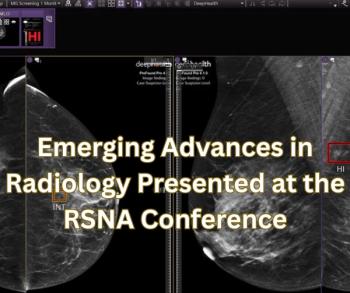
Pain, Anxiety Linked in Image-Guided Core-Needle Breast Biopsies
For the most part, women who undergo image-guided core-needle breast biopsies experience minimal pain.
Most patients report minimal pain during imaging-guided core-needle breast biopsies, according to a study published in the
[[{"type":"media","view_mode":"media_crop","fid":"25688","attributes":{"alt":"","class":"media-image media-image-right","id":"media_crop_922278254292","media_crop_h":"0","media_crop_image_style":"-1","media_crop_instance":"2390","media_crop_rotate":"0","media_crop_scale_h":"0","media_crop_scale_w":"0","media_crop_w":"0","media_crop_x":"0","media_crop_y":"0","style":"height: 300px; width: 150px; border-width: 0px; border-style: solid; margin: 1px; float: right;","title":" ","typeof":"foaf:Image"}}]]
Researchers from North Carolina, Ohio and Washington performed a small study to evaluate pain experienced during imaging-guided core-needle breast biopsies and to identify factors that predict increased pain perception during the procedures.
The 136 women who underwent either stereotactically or ultrasound-guided breast biopsy or cyst aspiration participated in the study. The researchers noted the procedure type for each participant, as well as experience level of the radiologist performing the biopsy, number of biopsies, breast density, histology and tumor size. The participants completed pre- and postbiopsy questionnaires, answering questions about ongoing breast pain, anticipatory prebiopsy pain and prebiopsy anxiety. Written and verbal instructions given to the participants before the biopsy included avoiding aspirin and NSAIDs before the procedure.
Measures included ongoing breast pain, anticipatory breast pain, pain experienced during breast biopsy, pain catastrophizing, anxiety, chronic life stress, perceived communication, and demographic and medical information.
The results showed that 39.7 percent of the participants reported no pain (0 on a scale of 0 to 10); 48.5 percent reported mild pain (One to three out of 10); and 11.8 percent reported moderate to severe pain (four or more out of 10). Significant predictors of greater biopsy pain “included younger age, greater prebiopsy breast pain, higher anticipated biopsy pain and undergoing a stereotactic procedure,” wrote the authors. “Anticipated biopsy pain correlated most strongly with biopsy pain.”
The authors concluded that most patients experienced minimal pain during imaging-guided biopsy procedures and those who did report pain tended to have higher concerns about pain before undergoing the procedure. “Communication with patients before biopsy regarding minimal average pain reported during biopsy and encouragement to make use of coping strategies may reduce patient anxiety and anticipated pain,” the authors wrote.
Newsletter
Stay at the forefront of radiology with the Diagnostic Imaging newsletter, delivering the latest news, clinical insights, and imaging advancements for today’s radiologists.




























